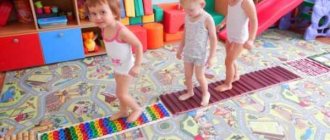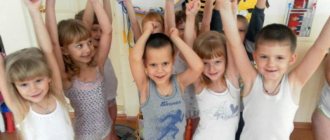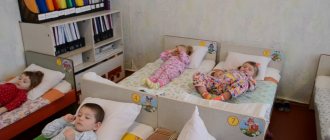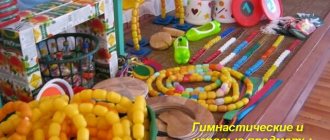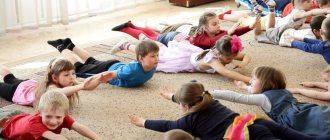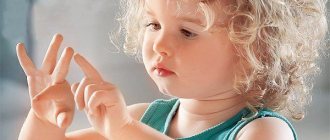Kindergarten teachers are amazing people. How many tricks do you need to know in order to take care of and protect, feed and clothe, occupy and develop boys and girls all day long, and even so that they are friendly, cheerful, and healthy! Special sets of gymnastic exercises help each child maintain a healthy mind in a healthy body.
A preschooler's day is divided in half by naps, and waking up becomes a transitional moment on which the child's mood will depend for the rest of the day. That is why gymnastics after sleep is carried out in kindergarten every day. Short in duration, almost imperceptible for the children themselves, it smoothly and carefully helps them fill with vigor and strength.
Types of gymnastics after sleep
In the methodological developments proposed by experts, the following types of gymnastics after sleep can be distinguished:
- exercises in bed with elements of self-massage;
- play gymnastics;
- gymnastics with exercise equipment and sports equipment;
- walking or jogging on massage mats/paths.
When preparing the exercise, you can use any exercise equipment that is available in the kindergarten
. As can be seen from the list, daytime gymnastics becomes a powerful set of health procedures, competently and concisely structured in time, and most importantly, interesting and enjoyable for the child.
All exercises are carried out in stages, with a gradual increase in load, and are of a playful nature. They are aimed at general strengthening of the body, prevention of disorders of posture, vision and flat feet. Psychologically, gymnastics classes unite children in a group and help them get out of the state of internal stiffness into which, as if in a capsule, the baby is immersed during sleep.
The teacher is free to choose specific exercises. He independently assesses the capabilities and needs of his students, observes which exercises are especially loved by children and, if desired, varies the tasks so as not to turn the magic of the five-minute sports session into a routine.
Meaning and benefits
Each child is individual, and if one easily wakes up after a lunchtime nap, for another it can become a real challenge. Therefore, in many kindergartens, teachers use a gymnastics complex that helps children quickly return to active mode. The main goal of such activities is to get the child accustomed to the skills of doing exercises, which in the future will form the habit of daily healthy exercises.
To make it easier for the student to accept new things, gymnastics is carried out in a group of children. When other children are nearby with the child, it is easier for him to understand the essence of the tasks, and if something turns out to be incomprehensible, you can always learn from the example of friends. In addition to building team spirit, exercise is very beneficial for health, as it affects all systems of the body:
- increases immunity;
- builds resistance to stressful situations;
- stimulates the nervous and respiratory systems;
- accelerates metabolic processes;
- accelerates blood circulation;
- optimizes the functioning of the cardiovascular system;
- trains muscles, toning them;
- prevents the appearance of flat feet and curvature of posture;
- develops fine motor skills and coordination of movements;
- increases cognitive abilities;
- improves mood.
Attention! Exercising after a nap should be done an hour before meals or some time after meals. A ventilated room without drafts should be chosen as a location.
Elements of gymnastics after sleep
Gymnastics after sleep is like a multi-colored mosaic that can be reassembled every day, creating a new image from its main elements. Daytime gymnastics, as an option, may include:
- stretching;
- breathing exercises;
- swing your arms;
- stroking biologically active zones;
- jumping;
- squats;
- simple elements of yoga;
- finger gymnastics;
- gymnastics for the eyes;
- visual-acoustic exercises.
Despite the fact that gymnastics after sleep is usually short-lived, the teacher can combine individual elements and use the developments he likes in fragments.
Video example of morning exercises:
Organization of gymnastics
All manipulations carried out with children must be carefully considered and comply with the Federal State Educational Standard (FSES) (federal state educational standards). This is a set of clear rules and requirements for education at a certain level. For the physical development of preschool children, there is a “Program for the training and education of preschool children,” which reflects the rules for conducting exercises for various groups, taking into account the age, physical and psychological development of children.
When organizing gymnastics, the teacher is guided by the following criteria:
- age;
- physical abilities of children;
- load distribution;
- complexity of exercises;
- duration;
- location.
Age
Taking into account this indicator, the set of exercises after lunch sleep differs. So, for younger children, exercises are carried out in a playful way, and the kids pretend to be birds, animals, and mother’s helpers. In this case, the teacher must complete each of the “exercises.”
In the preparatory group, children aged 5–6 years are more organized and independent, so the teacher can appoint the “eldest” child who will show the exercises to the whole group, and the rest of the children will repeat them. At this time, the teacher can devote time to individual work with specific children.
In the preparatory group, children remember the exercises performed daily, so they often practice doing warm-ups on their own.
Load distribution
A standard set of exercises is performed for 15–20 minutes. The distribution of the load is affected by curvature of posture, flat feet and other physiological problems. If there are none, the general scheme looks like this:
| Stage number | What to do | Description of the exercise | Duration (min.) |
| 1 | Arm and leg stretches | Performed in bed, immediately after waking up. You can continue the exercise in the form of alternate swings of arms and legs near the bed | 3 |
| 2 | Walking | The transition to the active phase continues with walking, from slow to gradually accelerating. You can start in a cool room | 3 |
| 3 | Active body movements | Movements to prevent problems of the musculoskeletal system are continued in a warm room. This can be active swings, bending, body turns, jumping, squats. It is recommended to supplement with sports equipment (skipping ropes, children's weights and dumbbells, etc.) | 5–7 |
| 4 | Breathing exercises | In a moderately cool room, exercise elements taken from breathing exercises | 3–4 |
Exercises for different groups
Gymnastics after sleep in the younger group
Daytime sleep is longest in the younger group of kindergarten. It can be difficult for kids to wake up in a good mood. If they were in a deep sleep, they may not immediately realize where they are. Children cry, are capricious, refuse to get up, wash, or get dressed. Therefore, during the exercises, the emphasis is on the emotional component of gymnastics: the correct selection of music, speech accompaniment, harmonization of the general atmosphere of the lesson. The images that the teacher will create during the exercises should be attractive.
Set of exercises “Sunshine”
A ray of sunshine woke up in the sky, A ray of sunshine reached out to the window.
There, outside the window, twenty children lie together in cozy beds. (Children stretch while lying in bed)
Hey, wake up, girls, boys!
You need to wear a dress and pants! Where are your pens? (Raise their hands and shake them in turn)
Where are your legs?
(Raise their legs, take turns doing swings)
Now we’ll play with you a little!
Come on, imagine that summer has come: The city has woken up, Rubbing their eyes with their fists).
And the sun rose.
(Raise their arms above their heads and stretch).
That is great!
So, let's ride into the distance along the path on a bicycle! (Doing the “Bicycle” exercise)
We drove and drove... - We arrived at the mill!
(Doing the “Mill” exercise)
Then we went. We drove, we drove... - We arrived at the river.
Let's help your feet, Let's touch some water! (They get up from the cribs, lowering their legs one by one to the floor)
Ay, the water is cold!
Here is one leg... (They jump on the right leg)
But here is another leg, what a nimble one!
(They jump on their left leg)
We stood in the water, Swimmed, (I make movements with my hands imitating swimming) We dived... Oh, good!
(They do squats with their arms extended forward)
They stood up from heel to toe and walked out onto the sand together.
(On tiptoes they walk out of the bedroom into the common room, where massage mats have already been prepared)
They walked on sand - They stepped on pebbles.
Oh, it's hot! (They walk in place on rubber mats for 2 minutes)
And now we have risen,
(Converge in the center of the hall)
We hold hands together.
(Form a circle)
Stretched,
(Stretched),
Smiled.
(Smile at each other).
Finally we woke up!
Gymnastics after sleep in the middle group
Gymnastics for middle group students should include a larger number of exercises. It is aimed not only at the emotional unity of children, but also at the comprehensive improvement of the child’s body. Elements of breathing exercises are required. It is advisable to combine gaming techniques with a set of exercises to prevent visual impairment and posture.
Rules
Since the work is carried out with children, it is necessary to strictly adhere to these rules. Regularly ventilate the room in which children study. In the warm season, exercises are carried out in the fresh air. For exercises that are performed on the floor, you need to acquire special gymnastic mats.
Clothes and shoes for exercise should be practical and comfortable. There is a complete absence of synthetic fabrics; instead, natural, loose fit is recommended. Exercises should be carried out at the same time every day. This will develop a systematic approach and teach children responsibility and order. Follow the sequence of gymnastic exercises.
So that the classes do not seem monotonous and do not tire the child, periodically it is necessary to supplement the existing complex with something new. Children's exercises are not designed for strength training. Therefore, you need to choose movements aimed at developing flexibility, coordination and increasing tone. It is necessary to constantly monitor the child’s condition, avoiding holding his breath. It is worth completing the gymnastics before the child gets tired.
Carefully! Sudden jerky movements and quick rises from the bed are not allowed. This is fraught with dizziness, darkening of the eyes and stretching of rested muscles.
Hardening
Hardenings are carried out if they are developed and reinforced by the preschool educational institution program. At the same time, the methods should be individually focused on each student, taking into account the health characteristics of each child. If there are many children in a group and an individual program is not possible, the following moderate hardening technique is recommended.
Some of the active exercises in the summer are carried out outdoors; in the colder season, children perform gymnastics in a cool room (18–20 °C) without shoes, wearing T-shirts and panties. Health-improving walking barefoot on rubber massage mats is carried out, alternating with steps into basins of water. You can complete the gymnastics complex by washing your face, hands, neck, and chest.
Hardening trains the body's defenses, which will make the child less susceptible to changing environmental factors
In summer, dousing with water at room temperature is acceptable. Children will also benefit from dosed sunbathing during the warm period from 9:00 to 11:00. The time should gradually increase from 3 to 20 minutes.
